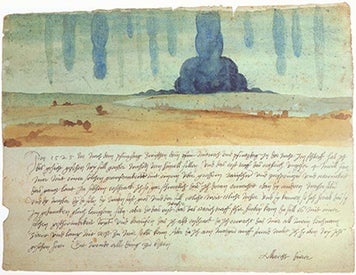This article was published in Scientific American’s former blog network and reflects the views of the author, not necessarily those of Scientific American
On the night of June 7th, 1525, the German Renaissance artist Albrecht Dürer dreamt about the Apocalypse. Captivated by the dream’s imagery, he committed it to a watercolor he rushed to paint after he woke.
Below the nightmarish scene, Dürer wrote:

Dream Vision (1525), by Albrecht Dürer
Watercolour on paper, 30 x 43 cm
Kunsthistorisches Museum, Vienna
On supporting science journalism
If you're enjoying this article, consider supporting our award-winning journalism by subscribing. By purchasing a subscription you are helping to ensure the future of impactful stories about the discoveries and ideas shaping our world today.
“In 1525, during the night between Wednesday and Thursday after Whitsuntide, I had this vision in my sleep, and saw how many great waters fell from heaven. The first struck the ground about four miles away from me with such a terrible force, enormous noise and splashing that it drowned the entire countryside. I was so greatly shocked at this that I awoke before the cloudburst. And the ensuing downpour was huge. Some of the waters fell some distance away and some close by. And they came from such a height that they seemed to fall at an equally slow pace. But the very first water that hit the ground so suddenly had fallen at such velocity, and was accompanied by wind and roaring so frightening, that when I awoke my whole body trembled and I could not recover for a long time. When I arose in the morning, I painted the above as I had seen it. May the Lord turn all things to the best.”
Today, Dürer’s “Dream Vision” is known as one of the first and most truthful pictorial representations of an image remembered from a dream (in contrast with idealized depictions of oneiric imagery by artists of the time). The core of Dürer’s experience is hardly unique, though – most of us can recall with some detail a few striking visions that came to us in our slumber. How such images relate to our waking visual experience has been less than clear, however, given the technical difficulties of communicating with someone in the midst of a dream.
A study published last August in Nature Communications has provided an important piece of the puzzle, by measuring the effects of rapid eye movements (REMs) on the responses of single neurons of human subjects during sleep. Previous research had found that REMs are remarkably similar to waking saccadic eye movements (the eye movements that we use to direct our gaze to successive points of interest in the visual field). Other prior work had moreover related the occurrence of REMs to dreams –indeed, the dreaming phase of sleep is often referred to as REM sleep. Yet, it was not known whether REMs signify overall arousability in a sleeping person, or alternatively indicate the specific times at which visual processing is updated (as waking saccadic eye movements do). In other words, do we use REMs to scan the images from our dreams?
Thomas Andrillon and his collaborators examined the relationship between REMs and neural activity, measured by intracranial electroencephalography (EEG) and single-neuron recordings from electrodes placed in epileptic patients (for medical reasons unrelated to the goal of the study). They found a strong association between REM production and neural activity –across the human medial temporal lobe and neocortex– that was reminiscent of visual-mnemonic neural responses observed during wakefulness.
The data –albeit somewhat limited by the fact that dream reports were not collected, and that the electrode placement was dictated by the patients’ medical needs– indicate that REMs behave like waking saccadic eye movements, and that they modulate neuronal activity in a way that is consistent with visual exploration of our dream scenarios.